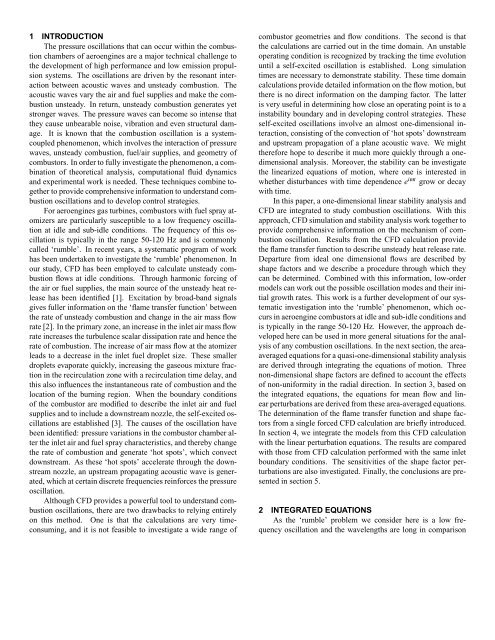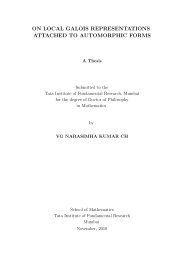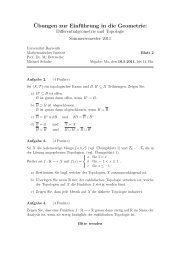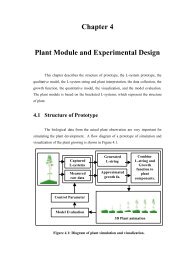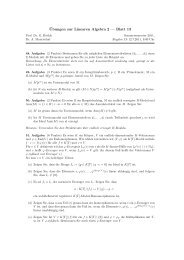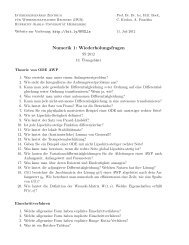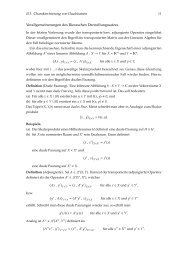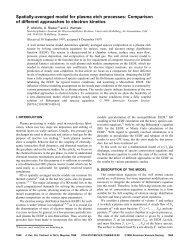integration of cfd and low-order models for combustion ... - IWR
integration of cfd and low-order models for combustion ... - IWR
integration of cfd and low-order models for combustion ... - IWR
You also want an ePaper? Increase the reach of your titles
YUMPU automatically turns print PDFs into web optimized ePapers that Google loves.
1 INTRODUCTION<br />
The pressure oscillations that can occur within the <strong>combustion</strong><br />
chambers <strong>of</strong> aeroengines are a major technical challenge to<br />
the development <strong>of</strong> high per<strong>for</strong>mance <strong>and</strong> <strong>low</strong> emission propulsion<br />
systems. The oscillations are driven by the resonant interaction<br />
between acoustic waves <strong>and</strong> unsteady <strong>combustion</strong>. The<br />
acoustic waves vary the air <strong>and</strong> fuel supplies <strong>and</strong> make the <strong>combustion</strong><br />
unsteady. In return, unsteady <strong>combustion</strong> generates yet<br />
stronger waves. The pressure waves can become so intense that<br />
they cause unbearable noise, vibration <strong>and</strong> even structural damage.<br />
It is known that the <strong>combustion</strong> oscillation is a systemcoupled<br />
phenomenon, which involves the interaction <strong>of</strong> pressure<br />
waves, unsteady <strong>combustion</strong>, fuel/air supplies, <strong>and</strong> geometry <strong>of</strong><br />
combustors. In <strong>order</strong> to fully investigate the phenomenon, a combination<br />
<strong>of</strong> theoretical analysis, computational fluid dynamics<br />
<strong>and</strong> experimental work is needed. These techniques combine together<br />
to provide comprehensive in<strong>for</strong>mation to underst<strong>and</strong> <strong>combustion</strong><br />
oscillations <strong>and</strong> to develop control strategies.<br />
For aeroengines gas turbines, combustors with fuel spray atomizers<br />
are particularly susceptible to a <strong>low</strong> frequency oscillation<br />
at idle <strong>and</strong> sub-idle conditions. The frequency <strong>of</strong> this oscillation<br />
is typically in the range 50-120 Hz <strong>and</strong> is commonly<br />
called ‘rumble’. In recent years, a systematic program <strong>of</strong> work<br />
has been undertaken to investigate the ‘rumble’ phenomenon. In<br />
our study, CFD has been employed to calculate unsteady <strong>combustion</strong><br />
f<strong>low</strong>s at idle conditions. Through harmonic <strong>for</strong>cing <strong>of</strong><br />
the air or fuel supplies, the main source <strong>of</strong> the unsteady heat release<br />
has been identified [1]. Excitation by broad-b<strong>and</strong> signals<br />
gives fuller in<strong>for</strong>mation on the ‘flame transfer function’ between<br />
the rate <strong>of</strong> unsteady <strong>combustion</strong> <strong>and</strong> change in the air mass f<strong>low</strong><br />
rate [2]. In the primary zone, an increase in the inlet air mass f<strong>low</strong><br />
rate increases the turbulence scalar dissipation rate <strong>and</strong> hence the<br />
rate <strong>of</strong> <strong>combustion</strong>. The increase <strong>of</strong> air mass f<strong>low</strong> at the atomizer<br />
leads to a decrease in the inlet fuel droplet size. These smaller<br />
droplets evaporate quickly, increasing the gaseous mixture fraction<br />
in the recirculation zone with a recirculation time delay, <strong>and</strong><br />
this also influences the instantaneous rate <strong>of</strong> <strong>combustion</strong> <strong>and</strong> the<br />
location <strong>of</strong> the burning region. When the boundary conditions<br />
<strong>of</strong> the combustor are modified to describe the inlet air <strong>and</strong> fuel<br />
supplies <strong>and</strong> to include a downstream nozzle, the self-excited oscillations<br />
are established [3]. The causes <strong>of</strong> the oscillation have<br />
been identified: pressure variations in the combustor chamber alter<br />
the inlet air <strong>and</strong> fuel spray characteristics, <strong>and</strong> thereby change<br />
the rate <strong>of</strong> <strong>combustion</strong> <strong>and</strong> generate ‘hot spots’, which convect<br />
downstream. As these ‘hot spots’ accelerate through the downstream<br />
nozzle, an upstream propagating acoustic wave is generated,<br />
which at certain discrete frequencies rein<strong>for</strong>ces the pressure<br />
oscillation.<br />
Although CFD provides a powerful tool to underst<strong>and</strong> <strong>combustion</strong><br />
oscillations, there are two drawbacks to relying entirely<br />
on this method. One is that the calculations are very timeconsuming,<br />
<strong>and</strong> it is not feasible to investigate a wide range <strong>of</strong><br />
combustor geometries <strong>and</strong> f<strong>low</strong> conditions. The second is that<br />
the calculations are carried out in the time domain. An unstable<br />
operating condition is recognized by tracking the time evolution<br />
until a self-excited oscillation is established. Long simulation<br />
times are necessary to demonstrate stability. These time domain<br />
calculations provide detailed in<strong>for</strong>mation on the f<strong>low</strong> motion, but<br />
there is no direct in<strong>for</strong>mation on the damping factor. The latter<br />
is very useful in determining how close an operating point is to a<br />
instability boundary <strong>and</strong> in developing control strategies. These<br />
self-excited oscillations involve an almost one-dimensional interaction,<br />
consisting <strong>of</strong> the convection <strong>of</strong> ‘hot spots’ downstream<br />
<strong>and</strong> upstream propagation <strong>of</strong> a plane acoustic wave. We might<br />
there<strong>for</strong>e hope to describe it much more quickly through a onedimensional<br />
analysis. Moreover, the stability can be investigate<br />
the linearized equations <strong>of</strong> motion, where one is interested in<br />
whether disturbances with time dependence e iωt grow or decay<br />
with time.<br />
In this paper, a one-dimensional linear stability analysis <strong>and</strong><br />
CFD are integrated to study <strong>combustion</strong> oscillations. With this<br />
approach, CFD simulation <strong>and</strong> stability analysis work together to<br />
provide comprehensive in<strong>for</strong>mation on the mechanism <strong>of</strong> <strong>combustion</strong><br />
oscillation. Results from the CFD calculation provide<br />
the flame transfer function to describe unsteady heat release rate.<br />
Departure from ideal one dimensional f<strong>low</strong>s are described by<br />
shape factors <strong>and</strong> we describe a procedure through which they<br />
can be determined. Combined with this in<strong>for</strong>mation, <strong>low</strong>-<strong>order</strong><br />
<strong>models</strong> can work out the possible oscillation modes <strong>and</strong> their initial<br />
growth rates. This work is a further development <strong>of</strong> our systematic<br />
investigation into the ‘rumble’ phenomenon, which occurs<br />
in aeroengine combustors at idle <strong>and</strong> sub-idle conditions <strong>and</strong><br />
is typically in the range 50-120 Hz. However, the approach developed<br />
here can be used in more general situations <strong>for</strong> the analysis<br />
<strong>of</strong> any <strong>combustion</strong> oscillations. In the next section, the areaaveraged<br />
equations <strong>for</strong> a quasi-one-dimensional stability analysis<br />
are derived through integrating the equations <strong>of</strong> motion. Three<br />
non-dimensional shape factors are defined to account the effects<br />
<strong>of</strong> non-uni<strong>for</strong>mity in the radial direction. In section 3, based on<br />
the integrated equations, the equations <strong>for</strong> mean f<strong>low</strong> <strong>and</strong> linear<br />
perturbations are derived from these area-averaged equations.<br />
The determination <strong>of</strong> the flame transfer function <strong>and</strong> shape factors<br />
from a single <strong>for</strong>ced CFD calculation are briefly introduced.<br />
In section 4, we integrate the <strong>models</strong> from this CFD calculation<br />
with the linear perturbation equations. The results are compared<br />
with those from CFD calculation per<strong>for</strong>med with the same inlet<br />
boundary conditions. The sensitivities <strong>of</strong> the shape factor perturbations<br />
are also investigated. Finally, the conclusions are presented<br />
in section 5.<br />
2 INTEGRATED EQUATIONS<br />
As the ‘rumble’ problem we consider here is a <strong>low</strong> frequency<br />
oscillation <strong>and</strong> the wavelengths are long in comparison


